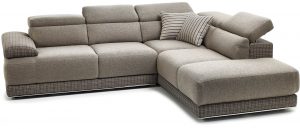Relationship between Europe and upholstered furniture market lends itself to an analysis of different sensitive aspects: world primacy of production brands, delocalization of production units, liveliness of domestic demand.
According to a recent Csil’s survey (Centre for Industrial Studies) 15 among the first 43 world producers of upholstered furniture are European. Their total impact on world export stands at 30%, second only to Asia-Pacific countries. Poland, Italy and Germany drive European exportation, able to hold off China.
In the last decade, the decrease of domestic production (- 14%) has been offset by delocalization, through the establishment of many European factories in Asia, where raw materials (wood, rattan, bamboo) are available and labour cost is lower. Factors such as these mitigate the effects of the economic and financial crisis which had a serious impact on Western companies.
Nonetheless, starting from 2011, the European production of upholstered furniture has been increasing, up to a +7% registered in 2016.
Domestic consumption occupied and occupies a relevant place in end markets, amounting approximately to 13 billion of euro in 2016 (+6% from 2011).
Also in Europe, Italy plays an important role for the satisfaction of demand, relying on upholstered furniture district such as near Forlì (city of Northeast Italy) and in Apulia and Basilicata (regions in Southern Italy). Latter two boast handcraft and commercial competences (with big brands and the undisputed penetration ability of little companies) which are known in the world for decades.
Gabriele Magliola’s experience demonstrates the success of the Apulian brand Italialiving (besides the brand with the same name, Semplice and Afosofà, too). Through them, some retail chains and Contract players are able to contribute to the development process of the product, in line with local consumer interests and tailored production. The recent introduction of a particular upholstery fabric which satisfies some specific local market preferences is an example. It happened in Lebanon, but company orientation aims to involve other European interlocutors into similar projects.
Focus is on Nordic Countries, able to suggest to production companies a well-defined driver, the sustainability.
For the Italian Ministry of Foreign Affairs, Sweden is the most prosperous market in the Nordic area, Norway the European country with the highest per-capita income and purchasing power levels, Denmark is really attracted by Italian lifestyle (furniture included), Finland manufactures high-quality design, considering “Made in Italy” complementary to its own production (big brands leave many interesting spaces for intermediate products).
Concerning furniture, all these countries have one thing in common: a demand that prefers clear wood, pastel colors, simplicity and naturalness for materials and lines and a reduced environmental impact. For Scandinavian people (except for Danes), upholstered furniture must have a fabric covering, not in leather. A practicable necessity for Italian fabric know-how and for complete products development, capable to combine the sobriety requested by northern Europeans with the “Made in Italy” design and creativity: different fibers, colors and textures on linear structures.

